Table of Contents
ToggleTypes of Lighting Used in Hockey Rinks and Ice Arenas
Flood Lights
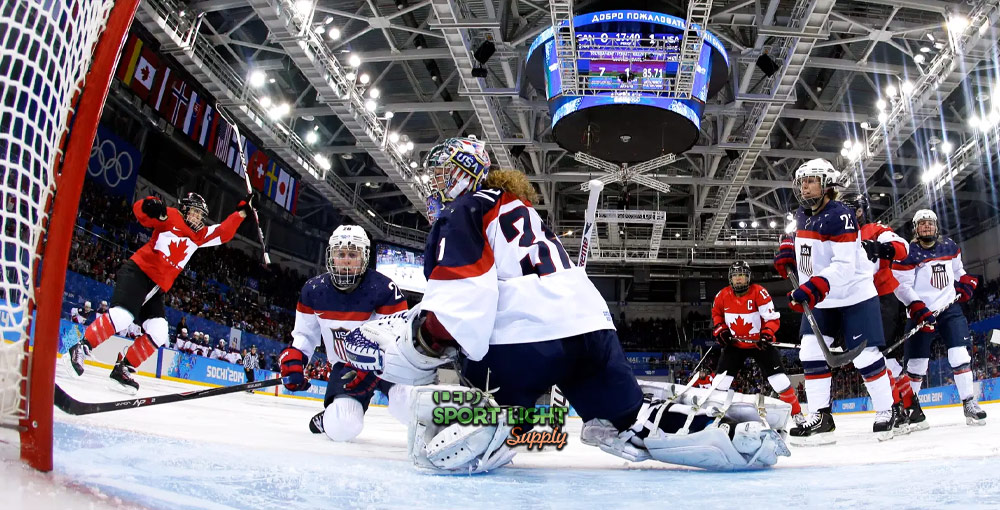
Flood lights are commonly used in ice hockey arenas, especially for outdoor rinks. These fixtures are designed to provide bright illumination over a large area from a relatively close distance. The layout of the ice rink and the distance between the flood lights and the rink are crucial factors in ensuring clear visibility for players and officials.
Flood lights are versatile and can be adjusted to highlight key areas of the rink, such as the goal zones and center ice. Their ability to deliver intense, even light helps players skate safely and perform at their best. The versatility of flood lights makes them essential for both enhancing gameplay and ensuring player safety by reducing shadows and uneven lighting.
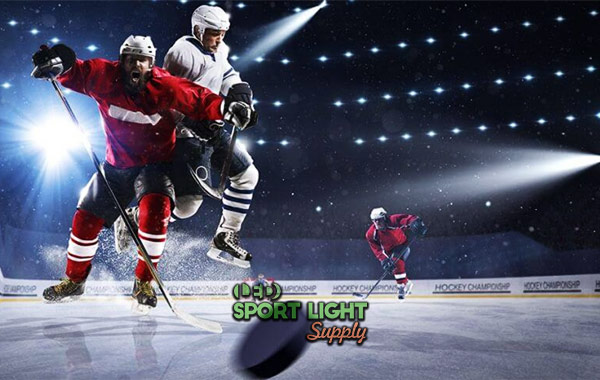
Spot Lights
Spot lights are typically used for long-range illumination in both indoor and outdoor sports arenas. They emit a narrow beam of light that can cover a large area without causing glare, provided they are installed at the correct height and distance.
These lights are crucial for maintaining visibility during high-speed action, such as in ice hockey. Spot lights help players and referees see the puck and the positions of other players clearly. Properly installed spot lights reduce the risk of injuries caused by inadequate lighting, making them a valuable component in any hockey rink.
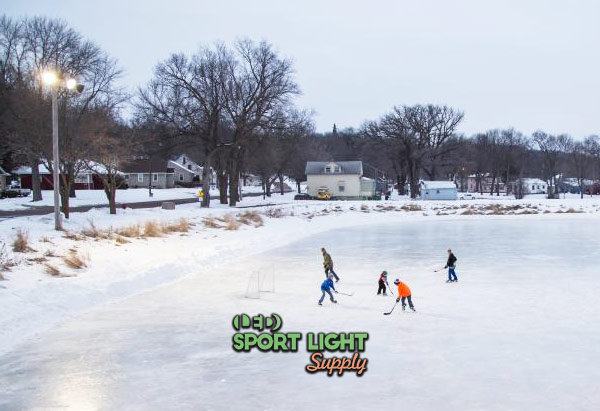
Pole Lights or High Mast Lights
In outdoor rinks, pole lights are positioned close to the rink, often near the goal areas and center ice. High mast lighting systems are used to mount energy-efficient LED flood lights and spot lights. These systems are designed to provide uniform lighting over a large area and are typically installed at a height that allows for optimal coverage.
High mast lights are essential for outdoor arenas, where they ensure that the entire rink is well-lit. The high placement of these lights helps reduce shadows and improves overall visibility. Regular maintenance is necessary to address potential issues such as corrosion, ensuring that the lights continue to function effectively.
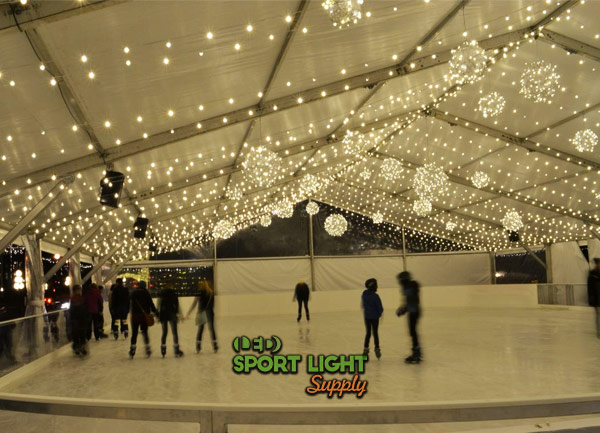
String Lights
For backyard hockey rinks or smaller ice arenas, string lights offer a decorative yet practical lighting solution. These lights can be strung around trees or other structures, creating a custom lighting design without the need for permanent fixtures.
String lights are usually LED-based and come in various wattages and designs. They are an economical choice for smaller rinks and can be equipped with features such as dusk-to-dawn sensors to automate lighting. While they may not offer the same intensity as other types of lighting, they provide a pleasant and functional illumination for recreational use.
UFO High Bay Lights
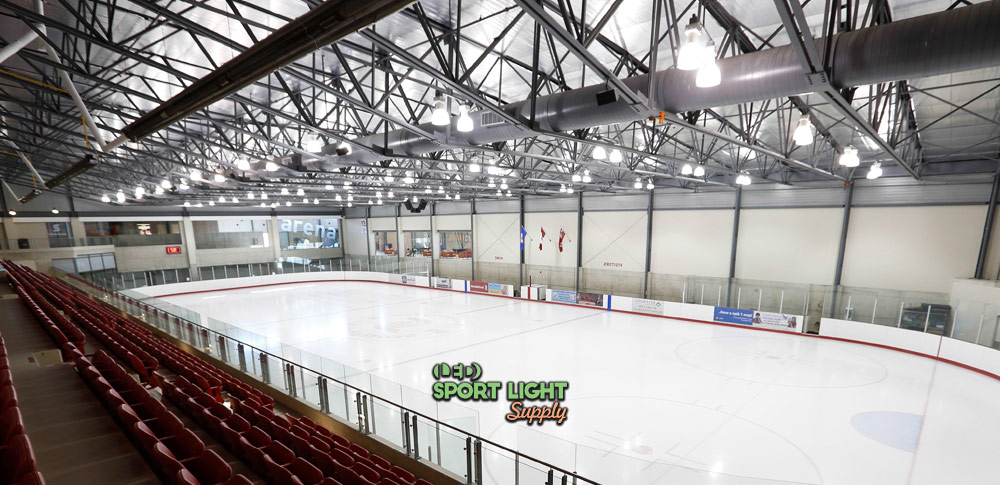
UFO high bay lights are used in indoor ice rinks to achieve uniform lighting across the arena. These lights, which are typically 100-150 watts, are mounted on the ceiling and are designed to cover the rink evenly.
In professional NHL arenas, UFO lights are often used in combination with spot lights to ensure optimal lighting conditions. These lights are straightforward to install, usually coming in separate components such as the lamp, power cords, and mounting brackets. Proper installation of UFO lights helps improve visibility for both players and referees, enhancing the overall experience of the game.
| Lighting Type | Pros | Cons |
|---|---|---|
| Flood Lights | Provides broad and even illumination; versatile and adjustable | May require frequent maintenance; potential for light pollution if not properly shielded |
| Spot Lights | Narrow beam reduces glare; ideal for high-speed action | Requires precise installation; may need multiple fixtures for adequate coverage |
| Pole Lights | Efficient for large outdoor areas; reduces shadows | High installation cost; maintenance required for high mast systems |
| String Lights | Economical and customizable; good for small areas | Less intense light; not suitable for professional use |
| UFO High Bay Lights | Ensures uniform lighting; easy to install | May need to be combined with other lights for optimal coverage |
Hockey Rink Lighting Design
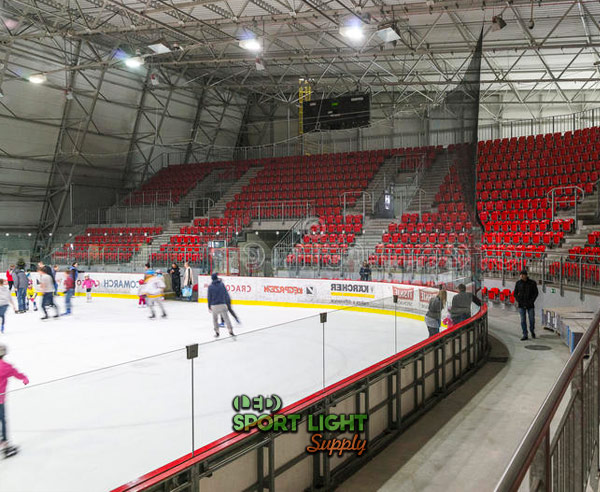
Lux (Brightness) Requirement
The lux level in an ice hockey arena is critical for ensuring adequate visibility during various events. Different levels of competition require specific lux values to maintain proper illumination.
| Competition Level | Lux Requirement |
|---|---|
| Championship League | 1,200 lux |
| Junior Championship | 800 lux |
| Local Tournaments and Junior Leagues | 500 lux |
| Practice and Training Sessions | 250 lux |
These lux levels are designed to cater to the needs of different types of events and ensure optimal lighting conditions.
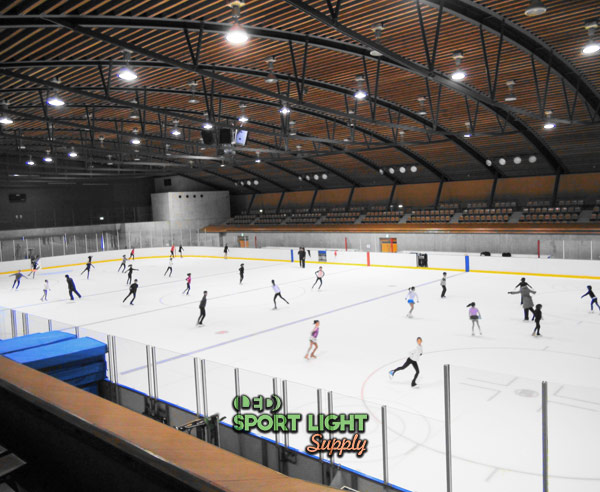
Lighting Uniformity
Lighting uniformity is vital for consistent illumination and player safety. It ensures that light is distributed evenly across the rink, minimizing distractions and improving concentration.
| Uniformity Type | Horizontal Uniformity Range | Vertical Uniformity Range |
|---|---|---|
| Overall Lighting Uniformity | 0.70 to 0.80 | 0.40 to 0.70 |
Achieving the recommended uniformity values helps maintain clear visibility and enhances the safety of players during fast-paced gameplay.
Color Temperature
The color temperature of lighting affects the appearance of the ice and player uniforms. It is measured in Kelvin (K) and influences how colors are perceived.
| Color Temperature Range | Description |
|---|---|
| Higher Kelvin Values | Cool, bluish light (above 5,000 K) |
| Lower Kelvin Values | Warm, yellowish light (below 5,000 K) |
| Ideal Range for TV Events | 4,000 to 6,500 K |
| Ideal Range for Ice Arenas | Neutral white tone |
Choosing the right color temperature ensures that uniforms appear accurate on camera and avoids unwanted color tints.
Color Rendering Index (Ra)
The Color Rendering Index (CRI) measures how well artificial light renders colors compared to natural light.
| CRI Value Range | Description |
|---|---|
| Above 90 Ra | Ideal for high visual comfort and accuracy |
| Between 70 and 90 Ra | Acceptable, considering fixture depreciation |
A high CRI value improves visual clarity and allows players to see the ice and opponents more distinctly.
Glare-Free Lighting
Minimizing glare is crucial in hockey rinks due to the reflective nature of the ice. Excessive glare can affect player visibility and gameplay.
| Glare Rating | Description |
|---|---|
| Maximum Permissible Value | 45 |
Proper fixture placement and glare shields help reduce glare, ensuring a clearer view for both players and broadcasters.
Beam Angle
The beam angle of lights affects how light spreads across the rink. Different angles are suitable for varying ceiling heights and rink sizes.
| Beam Angle Type | Description |
|---|---|
| Larger Beam Angles (90 to 120 degrees) | Ideal for smaller rinks or low ceilings |
| Smaller Beam Angles (30 to 60 degrees) | Suitable for high ceilings or focused lighting |
Using a combination of beam angles allows for flexible lighting solutions to achieve optimal illumination and uniformity.
Outdoor Ice Hockey Rink Lighting Layout
4-Pole Layout
The 4-pole layout is one of the simplest lighting configurations for outdoor ice hockey rinks. This design focuses on providing sufficient brightness for each goaltender to see the central zones of the rink clearly. Typically, the height of the outdoor light poles ranges from 3 meters to 20 meters, depending on the level of competition. Shorter pole heights are commonly used for local competitions and training sessions, though this can result in longer shadows.
A significant drawback of the 4-pole layout is the limited number of light points, which may lead to insufficient illumination around the rink walls. To mitigate this issue, lights can be installed behind the four corners of the ice rink. However, this adjustment might increase the risk of glare.
6-Pole Layout
The 6-pole layout is a popular choice due to its effectiveness in providing adequate brightness for small competitions and figure skating events. This configuration typically involves six high masts placed around the ice arena, each equipped with powerful luminaires mounted atop 20-meter poles.
The primary goal of the 6-pole layout is to create a cost-effective lighting solution. The poles do not need to be perfectly aligned around the rink, and each mast can hold multiple fixtures with varied tilts for both long- and short-range illumination. When portable light towers are used, this layout enhances visibility and helps reduce glare and shadows. This arrangement is especially useful in high mountain areas where glare reduction and shadow control are crucial.
8-Pole Layout
The 8-pole layout represents the most professional and suitable choice for outdoor hockey events. There are two main variations of this layout:
Standard Configuration
In this setup, eight light poles are strategically positioned around the hockey rink. Four poles are located near the blue lines, and two poles are positioned behind each goaltender.
Split Configuration
Here, four poles are placed on one side of the rink and four on the opposite side. While this variation might offer less uniform illumination compared to the standard configuration, it remains an efficient solution for brightening the ice arena and minimizing shadows.
The 8-pole layout is often preferred in situations where a compact and effective lighting solution is necessary. Although it may limit space for the penalty box and players’ benches, the vertical illuminance provided is generally superior to that of the 4-pole layout.
| Layout | Pros | Cons |
|---|---|---|
| 4-Pole Layout | Simplicity, cost-effective for local use | Insufficient illumination around rink walls, potential glare |
| 6-Pole Layout | Adequate brightness for small events, reduced glare and shadows, cost-effective | Requires careful placement of poles and fixtures |
| 8-Pole Layout | Professional quality, efficient shadow reduction, improved vertical illuminance | Less space for penalty boxes and benches, potentially less uniform illumination in split configuration |
Indoor Ice Rink Lighting Layout
Distance Between High Bay Lights on the Ice Rink Ceiling
Hanging high bay lights from the ceiling can significantly affect the lux readings on the artificial ice, especially if the cords are very long. One of the main advantages of using UFO high bay lights is the potential reduction in running costs. Adjusting the cord length to maintain optimal lighting quality is one way to manage expenses. Additionally, installing these lights is straightforward and allows for easy retrofitting in older facilities.
Many high bay light models feature stamped metal fins and optimized back housings designed for effective heat dissipation. The ceiling-mount bracket provides space for the heat sink to function properly, making these lights suitable for hockey rinks with low air exchange.
Ceiling Height
Ceiling height plays a crucial role in several aspects of lighting design. It influences the direction and efficiency (lm/W) of each fixture and affects the lumen maintenance factor, which in turn impacts the lux levels.
In modern indoor hockey rinks, LED lights are a cost-effective solution. While selecting lighting devices with a low failure rate is ideal, budget constraints may necessitate adjustments in fixture positioning. Using a lux meter can help achieve the required lux standards, but it is essential to ensure that reflections caused by the distance between light sources and the ice do not impair players’ visibility.
Number of Luminaries
When upgrading to high bay lights, the choice generally ranges from 50 to 200 LED fixtures. Designers can group these lights to create specific switch configurations, and advanced lighting control systems can provide efficient on/off control.
A greater number of luminaries enhances uniformity and improves the quality of play. For instance, attacking players require precise lighting to strike the puck accurately, and goaltenders need clear visibility to track the action. Additionally, a well-lit rink can heighten the excitement during events like penalty shots, enhancing the overall audience experience.
Shape of the Ice Rink Ceiling
The shape of the ice rink ceiling can significantly impact lighting design. Most NHL arenas feature vaulted ceilings, which vary in design to create distinctive visual experiences. A vaulted ceiling allows for diverse light patterns and better visual effects during events such as intermissions or figure skating performances.
Vaulted ceilings offer the advantage of extra frames for tilting lights, which can enhance the exposure of advertisements on the boards, benefiting sponsors. However, this may also necessitate placing many fixtures closely together. In contrast, flat ceilings simplify the design process. In such setups, corner spotlights are often used to illuminate the center ice, improving the fan experience.
Direct or Indirect Lighting
Architects may design a sports venue to utilize either direct or indirect lighting based on their goals for the rink.
Indirect Lighting: This method involves directing lights upward so that the reflected light illuminates the rink by bouncing off walls and the ceiling. Indirect lighting enhances uniformity and minimizes glare, but it generally requires more powerful light sources, leading to higher energy consumption.
Direct Lighting: This traditional approach involves hanging and tilting fixtures directly toward the ice rink. While it is more cost-effective, direct lighting can pose safety risks. To address this, stadium owners often invest in protective grilles and additional accessories.
Why LED is the Best Lighting for Ice Hockey Rinks
Reducing Electricity Bills
LED lights are highly efficient, with a luminous efficacy of approximately 150 lm/W. This efficiency is 2 to 4 times greater than that of traditional metal halide, high-pressure sodium (HPS), and high-intensity discharge (HID) lamps. By upgrading to LED lighting, ice hockey rinks can significantly reduce their operational costs while also benefiting from a more environmentally friendly solution. The enhanced efficiency of LED lights translates to lower electricity consumption, making them a cost-effective choice for long-term energy savings.
Long Lifespan
LED floodlights are renowned for their longevity. Most high-quality LED fixtures have a lifespan of at least 50,000 hours, which far exceeds that of traditional lighting options. This extended lifespan reduces the frequency of replacements and lowers maintenance costs. Additionally, LED technology features binned chips, meaning that each group of LED chips can independently provide different color temperatures. If a specific color temperature becomes unavailable, the system can switch to another range, extending the usability of the existing lights until a replacement is installed.
Anti-Glare Properties
LED lights can be designed to minimize glare, which is particularly beneficial for ice rinks. Certain manufacturers offer LED lights specifically engineered to be anti-glare, reducing reflections on the ice surface and improving visibility for players and spectators. This design often involves recessing the light source further back inside the casing or applying special coatings and lenses to enhance light diffusion. Reduced glare contributes to a more comfortable environment for ice skaters and can help prevent injuries caused by harsh lighting conditions.
Maintaining Ice Quality
Unlike traditional lighting sources, LED lights generate minimal heat. Each LED fixture is equipped with a heat sink that efficiently dissipates any heat produced, preventing overheating. This characteristic is crucial for maintaining the quality of the ice rink and the coating on the ceiling. While proper air circulation is beneficial, the low heat emission from LED lights ensures that they do not adversely affect the rink’s conditions. In contrast, older high-pressure sodium (HPS) and metal halide (MH) lamps tend to overheat, which can negatively impact their lifespan and performance.
Wide Range of Color Temperature Options
Modern LED products offer a diverse range of color temperature options, allowing for customizable lighting solutions tailored to the specific needs of recreational or professional ice rinks. This flexibility helps create the ideal lighting environment for various activities and events, enhancing both the functionality and aesthetic appeal of the rink.
Cost of Ice Hockey Rink Lighting
The cost of lighting for an ice hockey rink can vary widely based on several factors, including the size of the rink, the height of the light poles, and the level of competition. On average, you can expect to invest between $8,000 and $150,000 in lighting systems. While the price may differ depending on the provider and the quality of the fixtures, choosing a reputable supplier often results in better performance and more reliable lighting solutions.
Conclusion
Flood lights are great for broad, even illumination, while spot lights offer precise lighting for high-speed action. Pole and high mast lights are ideal for large outdoor arenas, and string lights provide a customizable option for smaller spaces. UFO high bay lights excel in indoor settings with uniform coverage and ease of installation.
LED lighting is the top choice for ice hockey rinks due to its efficiency, long lifespan, anti-glare features, and low heat emission, making it both cost-effective and eco-friendly. Proper lighting enhances visibility, player safety, and overall rink experience.
